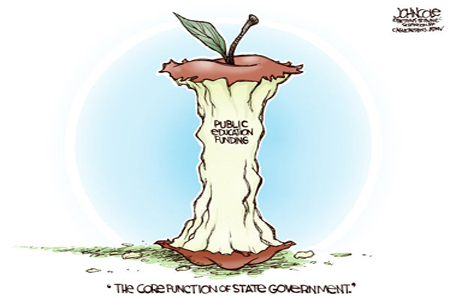Approximately, 3,000 students, 1 college councilor, 10 class advisors, and an average of 40 to 50 students in each class. This was my experience at a public high school in southern California. There was little staff or resources available to students and opportunities continued to decline as the district LAUSD received numerous budget cuts. As a result, many students did not receive a good education, classes were too full, there wasn't enough funding for science projects, and there was no one on one time with teachers.
Total Per-Student Expenditures Versus Student Poverty Rates for U.S. School Districts with More Than 1,000 Enrollment

Source: Prepared using information from the Common Core of Data for 1995, School District Data Book, National Center for Education Statistics (2000b).
This graph shows the relationship between low income students and the amount of money allotted from the government to each student. Many minority students live in these areas and would explain the correlation of minority students that go on to college. As a result, these students have to face more difficulties than students who have a private school education.
I went to a predominantly Hispanic high
school and during the college application process, every day I saw one my
friends ruining their lives because they didn’t think they could get in to
college or they didn’t have the ability to pay for it. It was until I got to college that I have
been reflecting on this experience. The only
reason I was able to prepare a good college application and get a private
school education is because my parents were motivated and got the information
that we needed to succeed. Otherwise, I
would have been another one of those kids trying to find my way through the
complicated politics and information of the college world. Although I have always admired the staff at
my public high school, there was just simply not enough resources and
information given to the students for them to succeed. We wonder why there isn’t a lot of diversity
on a lot of college campuses. We are led
to believe that a minority student going to college is someone who is rising up
against the social norms, which is why we put this on our college
application. Apparently, it is something
“unique” and “special” for a Hispanic woman to get a higher education. It is it precisely this type of thinking that
discourages minority children to seek out higher education. There are ways to
pay for college and get good grades, but unfortunately nobody knows about them.

Fortunately, I was able to attend both a public and a private school for high school. Reflecting on this post brings certain comparisons of these two experiences in mind. In my private school there were three college counselors for the junior and senior class (200 students), and there were only two college counselors for the juniors and seniors (700 students) in the public school. There were many personal counselors and planning and teach aides in both schools. I also grew up in a predominately split white and Asian neighborhood, so the diversity was low. The income level of the neighborhood would put it in the upper class. The expectations of the schools were that most of the kids would be attending more schooling after graduation. Those who dropped out of school or did not have aspirations for higher education were seen as outsiders. These experiences in comparison with the author's above put mine in perspective. The demographics were very different as well as the population of kids in the school. They are not surprising to me, but they do feel unfair.
ReplyDeleteMy high school had similar staff and funding issues in common with your school. The school was smaller, 2,000 students, and the counseling staff was bigger, but there were still issues with finding time for the counselors. I think this shows how bad schools with conditions like yours is when schools that have much better conditions then yours still face these issues. The funding of minority students is also very disturbing, but not surprising to me. In Minnesota, where I am from, public schools get funding based on the value of neighborhood property taxes. This causes a great funding gap between city and suburban schools. The property values in the suburbs are twice or three times higher than most city houses. A large majority of minorities live in the cities, so the minority students at public schools are generally less funded than white suburban students. I hope that other states fund schools differently but in Minnesota racial and socioeconomic discrimination go hand in hand.
ReplyDelete